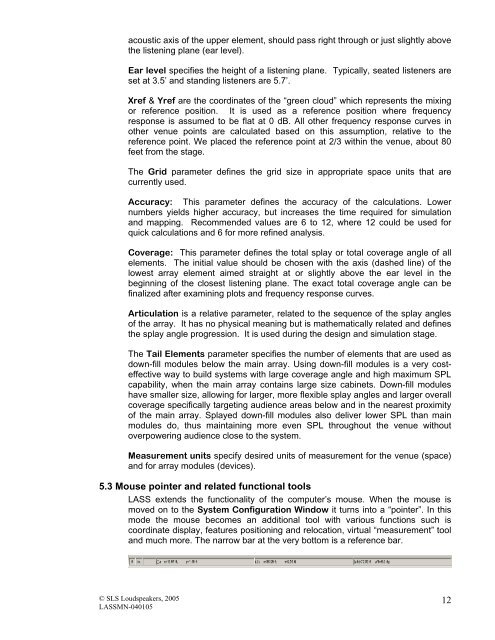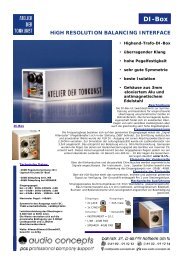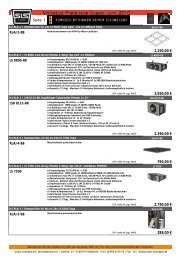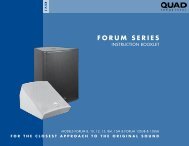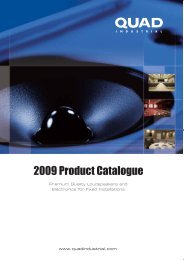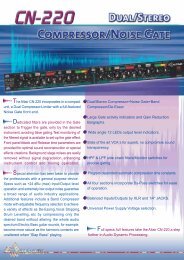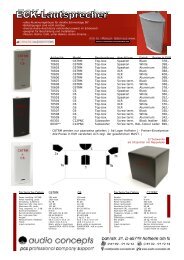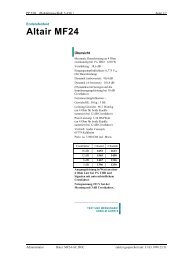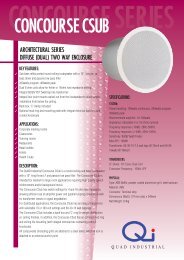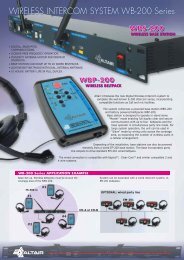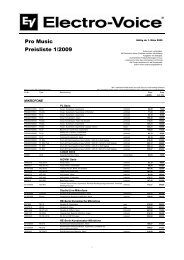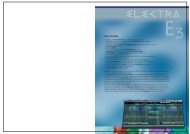LASS user manual - audio concepts
LASS user manual - audio concepts
LASS user manual - audio concepts
Create successful ePaper yourself
Turn your PDF publications into a flip-book with our unique Google optimized e-Paper software.
acoustic axis of the upper element, should pass right through or just slightly above<br />
the listening plane (ear level).<br />
Ear level specifies the height of a listening plane. Typically, seated listeners are<br />
set at 3.5’ and standing listeners are 5.7’.<br />
Xref & Yref are the coordinates of the “green cloud” which represents the mixing<br />
or reference position. It is used as a reference position where frequency<br />
response is assumed to be flat at 0 dB. All other frequency response curves in<br />
other venue points are calculated based on this assumption, relative to the<br />
reference point. We placed the reference point at 2/3 within the venue, about 80<br />
feet from the stage.<br />
The Grid parameter defines the grid size in appropriate space units that are<br />
currently used.<br />
Accuracy: This parameter defines the accuracy of the calculations. Lower<br />
numbers yields higher accuracy, but increases the time required for simulation<br />
and mapping. Recommended values are 6 to 12, where 12 could be used for<br />
quick calculations and 6 for more refined analysis.<br />
Coverage: This parameter defines the total splay or total coverage angle of all<br />
elements. The initial value should be chosen with the axis (dashed line) of the<br />
lowest array element aimed straight at or slightly above the ear level in the<br />
beginning of the closest listening plane. The exact total coverage angle can be<br />
finalized after examining plots and frequency response curves.<br />
Articulation is a relative parameter, related to the sequence of the splay angles<br />
of the array. It has no physical meaning but is mathematically related and defines<br />
the splay angle progression. It is used during the design and simulation stage.<br />
The Tail Elements parameter specifies the number of elements that are used as<br />
down-fill modules below the main array. Using down-fill modules is a very costeffective<br />
way to build systems with large coverage angle and high maximum SPL<br />
capability, when the main array contains large size cabinets. Down-fill modules<br />
have smaller size, allowing for larger, more flexible splay angles and larger overall<br />
coverage specifically targeting audience areas below and in the nearest proximity<br />
of the main array. Splayed down-fill modules also deliver lower SPL than main<br />
modules do, thus maintaining more even SPL throughout the venue without<br />
overpowering audience close to the system.<br />
Measurement units specify desired units of measurement for the venue (space)<br />
and for array modules (devices).<br />
5.3 Mouse pointer and related functional tools<br />
<strong>LASS</strong> extends the functionality of the computer’s mouse. When the mouse is<br />
moved on to the System Configuration Window it turns into a “pointer”. In this<br />
mode the mouse becomes an additional tool with various functions such is<br />
coordinate display, features positioning and relocation, virtual “measurement” tool<br />
and much more. The narrow bar at the very bottom is a reference bar.<br />
© SLS Loudspeakers, 2005<br />
<strong>LASS</strong>MN-040105<br />
12


